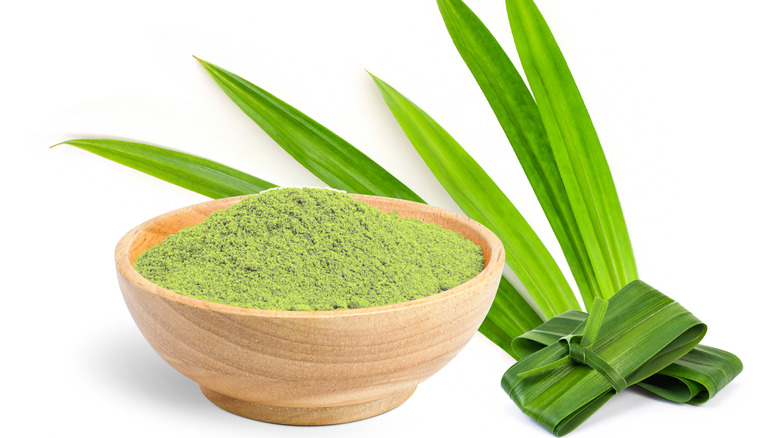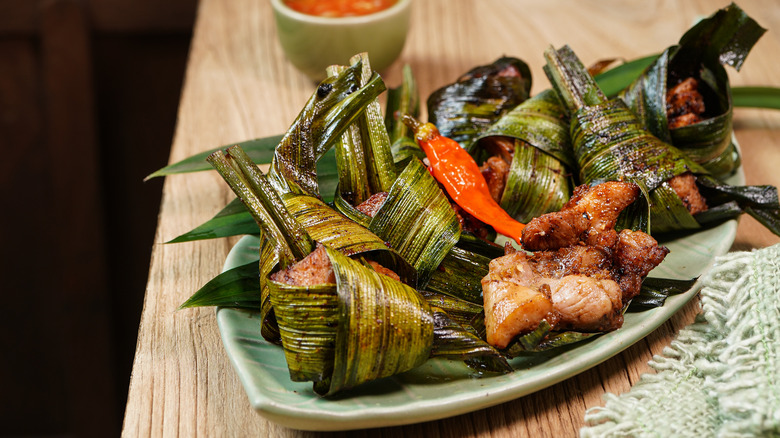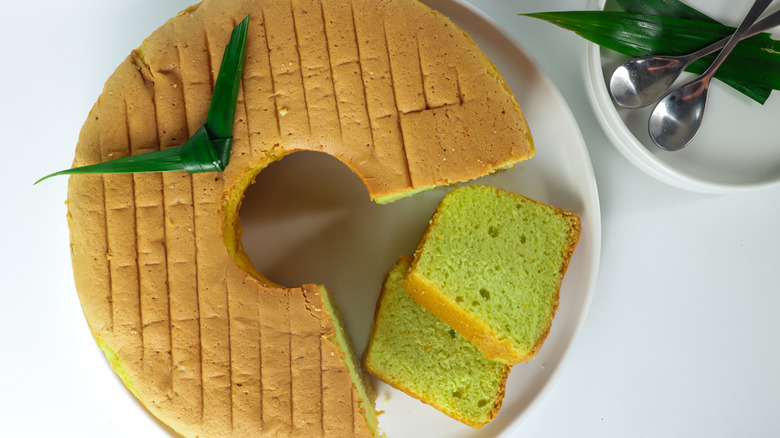What Exactly Is Pandan, And What Does It Taste Like
Asian desserts are having a moment in the United States. From halo-halo to falooda, there are many Asian desserts and drinks to salivate for. If you ever step foot into an Asian bakery, there's often an array of pandan-flavored baked goods that can make choosing just one hard to do. While pandan is typically enjoyed in Southeast Asian cuisines — green pandan waffles are a beloved Vietnamese street food — the green concoction is growing in popularity around the world. English chef and TV personality Nigella Lawson took notice of the pandan craze in 2017, calling it the "new matcha," according to The Telegraph.
Sometimes called the "Asian vanilla," in Southeast countries, including Malaysia, Thailand, Vietnam, and Indonesia, pandan is frequently used like, well, vanilla in the West. Now, pandan is increasingly becoming a go-to cooking ingredient in the United States. Pandan comes in many forms. Pandan leaves, extract, and paste can be found in Asian grocery stores. Here's what you need to know before adding the ingredient to your pantry.
What is pandan
Pandan, also known as screwpine, is a tropical green plant with long, spikey leaves. There are over 600 species of pandan, but only a few are edible. Pandan is a culinary ingredient that originated on the Indonesian island of Molucca. It was first widely used in Indonesia, Malaysia, and the Philippines. Today, pandan is widely used in Southeast Asia to flavor desserts and savory dishes. The green leaves are notable for their earthy, sweet, and floral aroma and taste. Pandan radiates a scent that Eater describes as "floral, grassy" and "sweet and musky" when cooked.
Pandan leaves have numerous health benefits, according to Nourish by WebMD. Pandan is a "rich" source of vitamin A and other antioxidants, including vitamin C, beta-carotene, and riboflavin. These nutrients can help improve people's immune systems and prevent diseases, such as cancer, diabetes, and cardiovascular disease. The plant has been used in traditional medicine to "treat constipation, boils, and cold- or flu-like symptoms," according to Healthline.
How to use pandan
While the leaves itself is seldom eaten, pandan is often used as a paste, extract, or powder. In fact, in many Southeast Asian cuisines, "pandan is used principally for aroma and secondarily for color, and very often for both simultaneously," cookbook author Christopher Tan tells Eater.
Typically pandan leaves are used to wrap food for steaming or frying. In some cultures, pandan leaves are added to dishes for fragrance, such as rice in Indonesia and Vietnam or curry sauces in Thailand and Malaysia. Not sure how to use pandan? The ingredient pairs well with coconut milk, turmeric, and lemongrass.
An easy way to incorporate pandan into dishes is by using it as coloring. Simply blend the leaves with water and then add it to your batter or mixture. If you want to whip up sweet treats or desserts, you can add pandan paste to cakes and sweet bread. If you're feeling adventurous, try making sticky rice with pandan and coconut or bánh bò, a Vietnamese pandan-flavored honeycomb cake. If this is your first time using pandan, it's better to stick with pandan extract, bakery owner Brian Tran tells Eater. "It's very easy to come by, it's inexpensive, and you can swap it for recipes that use vanilla."
Buying fresh pandan leaves? They last about four days in the refrigerator if wrapped in a damp paper towel or plastic bag. Frozen pandan leaves last longer, about six months in the freezer.


